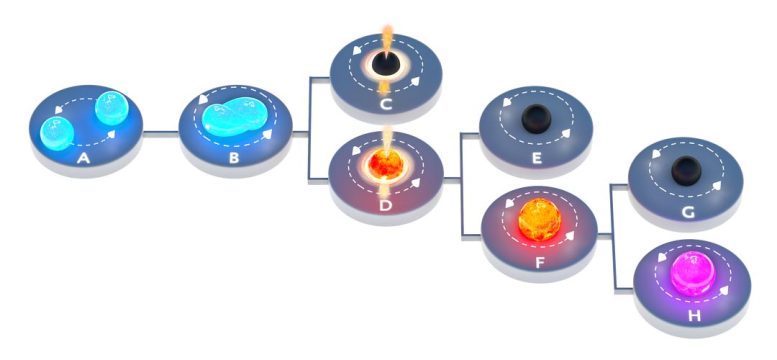
Schematic representation of binary neutron star merger outcomes. Panels A and B: Two neutron stars merge as the emission of gravitational waves drives them towards one another. C: If the remnant mass is above a certain mass, it immediately forms a black hole. D: Alternatively, it forms a quasistable ‘hypermassive’ neutron star. E: As the hypermassive star spins down and cools it can not support itself against gravitational collapse and collapses into a black hole. F, G: If the remnant’s mass is sufficiently low, it will survive for longer, as a ‘supramassive’ neutron star, supported against collapse through additional support against gravity through rotation, collapsing into a black hole once it loses this support. H: If the remnant is born with small enough mass, it will survive indefinitely as a neutron star. Schematic from Sarin & Lasky 2021. Credit: Carl Knox (Swinburne University)
On August 17th, 2017, LIGO detected gravitational waves from the merger of two neutron stars. This merger radiated energy across the electromagnetic spectrum, light that we can still observe today. Neutron stars are incredibly dense objects with masses larger than our Sun confined to the size of a small city. These extreme conditions make some consider neutron stars the caviar of astrophysical objects, enabling researchers to study gravity and matter in conditions unlike any other in the Universe.
The momentous 2017 discovery connected several pieces of the puzzle on what happens during and after the merger. However, one piece remains elusive: What remains behind after the merger?
In a recent article published in the journal General Relativity and Gravitation, Nikhil Sarin and Paul Lasky, two OzGrav researchers from Monash University, review our understanding of the aftermath of binary neutron star mergers. In particular, they examine the different outcomes and their observational signatures.
The fate of a remnant is dictated by the mass of the two merging neutron stars and the maximum mass a neutron star can support before it collapses to form a black hole. This mass threshold is currently unknown and depends on how nuclear matter behaves in these extreme conditions. If the remnant’s mass is smaller than this mass threshold, then the remnant is a neutron star that will live indefinitely, producing electromagnetic and gravitational-wave radiation. However, if the remnant is more massive than the maximum mass threshold, there are two possibilities: if the remnant mass is up to 20% more than the maximum mass threshold, it survives as a neutron star for hundreds to thousands of seconds before collapsing into a black hole. Heavier remnants will survive less than a second before collapsing to form black holes.
Observations of other neutron stars in our Galaxy and several constraints on the behavior of nuclear matter suggest that the maximum mass threshold for a neutron star to avoid collapsing into a black hole is likely around 2.3 times the mass of our Sun. If correct, this threshold implies that many binary neutron star mergers go on to form more massive neutron star remnants which survive for at least some time. Understanding how these objects behave and evolve will provide a myriad of insights into the behavior of nuclear matter and the afterlives of stars more massive than our Sun.
Reference: “The evolution of binary neutron star post-merger remnants: a review” by Nikhil Sarin and Paul D. Lasky, June 2021, General Relativity and Gravitation.
DOI: 10.1007/s10714-021-02831-1
Written by PhD student Nikhil Sarin, University of Adelaide









Be the first to comment on "The Aftermath of Binary Neutron Star Mergers: What Remains Behind?"